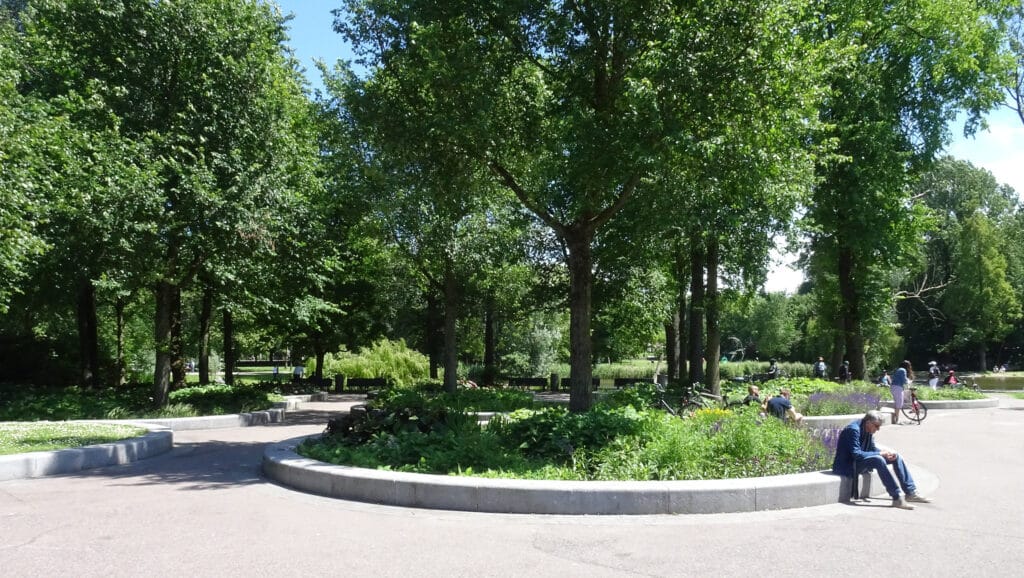L'Oosterpark serves Amsterdam's culturally diverse eastern district.
Many new arrivals from Suriname, Turkey, Morocco and more recently Eastern Europe live in the region.
Oosterpark is their walking and picnic area.
Focus on one of Amsterdam's most popular parks.
Oosterpark Amsterdam: article summary
Discover the history of Amsterdam's Oosterpark
The Oosterpark was the first major public park to be created by the municipality of Amsterdam. It was designed in 1891 by Leonard Antonij Springer (1855-1940), one of the country's leading landscape architects.
To build this large-scale park, the municipality decided to remove a cemetery from the area and demolish a number of smaller estates.
Singer, author of almost 900 different projects, designed the park around an elongated lake in which he resulting in an English landscape style that dominates Dutch landscape architecture to this day.

A sculpture garden of monuments
The Oosterpark is home to several important monuments and numerous sculptures.
The National Slavery Monument (Nationaal Monument Slavernijverleden) by Surinamese-born artist Erwin Jules de Vries commemorates the abolition of slavery in the Netherlands (1861).
Another large monument, a 4.5-metre-high modern sculpture by Jeroen Henneman called "The Scream" ("De schreeuw") is a memorial to the filmmaker Theo Van Gogh (1957-2004), a distant cousin of the painter.
Smaller sculptures to discover
Another sculpture made from stainless steel pipes by contemporary artist and writer Jan Wolkers commemorates the Dutch literary movement known as De Tachtigers.
A nice little bronze representing three men sitting on the bench called "Titaantjes" by Hans Bayens. a monument to the writer Nescio and his colleagues.
Since 2005, a specially placed stone has marked a public space dedicated to freedom of expression. From this small stage, locals and tourists alike can freely express their thoughts.
Of course, the park is full of other small sculptures. that make the visit even more interesting.
Oosterpark in Amsterdam: a highly developed wildlife scene
The Oosterpark is home to a large population of wild birds. Ashy herons are the most conspicuous, but you may also spot parrots, rare in the wild in Western Europe.
The shady western edge of the park's lake is teeming with wild ducks. Many other birds also have nests in the park, so it's only natural not difficult to observe even on a short visit.
Why should you visit Amsterdam's Oosterpark?
The park is well maintained and clean, with lots of tall trees and wide open spaces, perfect for a picnic.
Many birds hide in a corner of the Oosterpark. A fenced-in children's playground is also available.
All these things make this place an incredible place to visit.
How do I get to the Oosterpark?
Located in the city center, you'll have no trouble getting there. For example, you can visit Amsterdam's Oosterpark:
- On foot, from the Tropenmuseumthe park is located just behind the museum
- Visit tramway take line 9 and get off at the Eerste van Swindestraat stop. Alternatively, take lines 3 and 7 to the Beukenweg stop.
- Visit bus line 22 takes you to the Eerste van Swindestraat stop.
- Finally, you can take your car from the A10 and take exit S113, after which you'll need to continue towards the town center for about 5 km.
Amsterdam's Oosterpark is one of the places I recommend you visit on your vacation. Here, you can take a break between two visits and enjoy a bite to eat. or enjoy a little peace and quiet on a busy day.
What to do in Amsterdam in 1 day, 2 days, 3 days, 5 days, a week?
Whatever the length of your stay, I invite you to download my special Amsterdam guide.
It's free and in PDF format.
All you have to do is tell me below which e-mail address you'd like to receive it at.
EDIT: you can't enter your email?
Take the quiz at the top of this article and you'll be able to register your email address to receive the special Amsterdam guide!
Leave a Reply